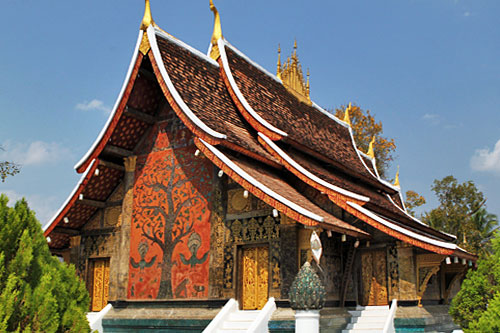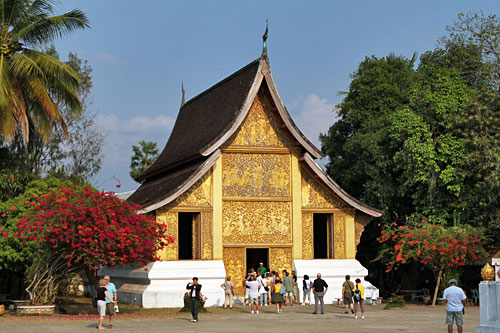After I’d dropped my last packet of biscuits and dollops of sticky rice into the monks’ pots during the daily alms giving ceremony in Luang Prabang, Laos, I followed the saffron robed procession through the rear gate of Wat Xieng Thong. A bold sun rode majestically into a robin’s egg sky, igniting the gilt facade of the chariot house on one side of the courtyard. On the other side, sparks burst from a colored glass mosaic tree of life that adorned an entire wall of one of the temples. Squinting in the dazzling light I wandered around Wat Xieng Thong, the Temple of the Golden City, reputedly the most beautiful temple in Laos.


The monks vanished into their quarters and alms givers melted back into their hotels and houses, leaving me mostly alone. I fought the temptation to go back to the Luang Say Residence and slide beneath the silky duvet on my enormous four-poster bed for a few more hours of delicious sleep, deciding instead to make the most of the morning light by touring some of the city’s historic temples.
According to legend, the Buddha smiled when he rested for a day at the sire of present day Luang Prabang, prophesying that it would become a rich and powerful capital city. The prophesy came true; for hundreds of years Luang Prabang served as both the capital of the powerful kingdom of Lan Xang, whose wealth and influence can be attributed to its location at a crossroads on the Silk Route, and the center of Buddhism in the region. The city lost its capital designation in the 15th century but remained the seat of the royal family until the communists took over in 1975 and dissolved the monarchy, and is still considered to be the spiritual and artistic center of Laos. More than 30 of the town’s original 60+ temples have been preserved and are scattered across the narrow peninsula at the confluence of the Mekong and Nam Khan Rivers that forms the heart of the city. Reflecting diverse architectural influences that range from an era when neighboring Thailand invaded to the French occupation in the 19th and 20th centuries, most are easily seen on a walking tour around neighborhoods where traditional Lao huts stand shoulder to shoulder with stately French colonial mansions. In addition to Wat Xieng Thong (above) the more spectacular temples in this UNESCO World Heritage town include the following:
Wat Visounnarath (also known as Wat Visoun or Wat Wisunarat)
The deceptively simple exterior of the sim (chapel) did not prepare me for the collection of centuries-old bronze and gilded Buddha statues house inside, all clustered around a behemoth gold Buddha that smiles benignly down on visitors. Built in the earliest Lao architectural style, Wat Visoun is the oldest functioning wat in Luang Prabang and is unique for the sloping front roof that covers the entrance. However it is most famous for its lotus stupa, which Lao people call Makmo or watermelon stupa due to its rounded dome, the only one of its kind in Laos.
Wat Souvanna Khiri
Near the end of the peninsula, where the Nam Khan River makes a sharp bend before entering the Mekong, I wandered into Wat Souvanna Khiri, the Monastery of the Golden Mountain. Interesting for its melange of architecture, which combines an early Lao style sim and outbuildings with French colonial mansions that are used as residences for the monks, the real fascination at this temple was a note tacked on the wall about chanting ceremonies with the monks, held every afternoon at 5:30 p.m. I returned later that same day and sat cross legged at the back of the tiny chapel, letting the soothing drone of the chants wash over my body and settle my mind.
Wat Sop
Though Wat Sop is one of the smallest monasteries in Luang Prabang, I found the interior of the sim to be one of the most charming. Its feminine looking golden Buddha sits in lotus position against a gold emblazoned red lacquer wall, surrounded by religious artifacts, and the multi-color carpets spread over the red tile floor provide a comfortable place for meditation or a cool escape from oppressive midday heat.
Can’t view the above slide show of the temples of Luang Prabang, Laos? Click here.
Wat Sene Souk Haram
Also known as Wat Saen, this Thai style wat is covered with yellow and red tiles that glow orange in the setting sun. Some insist its name, which translates to “Temple of 100,000 Treasures,” refers to 100,000 stones from the Mekong River used in its construction, while others claim it refers to the number of golden lotus blossoms on its walls. Whichever story is true, there is little doubt that his is one of the most beautiful temples in Luang Prabang.
Wat Ho Prabang and the National Museum at the Royal Palace Compound
After the dissolution of the monarchy in 1975, the Royal Palace was converted to the National Museum. The large entry hall and former throne room displays royal swords and scabbards, the king’s personal howdah (elephant saddle) and precious Buddha images. The five simple rooms at the rear that served as royal quarters have been largely preserved and offer a fascinating glimpse into life of the monarchs. However I almost missed the most important display in the entire complex. In the right front corner of the palace, the king’s former shrine room now holds the Prabang, a standing Buddha image with palms facing forward, cast in bronze and covered in gold leaf. Luang Prabang takes its name from the sacred image, which was brought to the ancient capital city in 1353 from Angkor Wat in Cambodia and used to spread Theravada Buddhism in the new kingdom. The statue will eventually be moved to Wat Ho Prabang, an elaborate, ornate temple still being constructed on the grounds of the former Royal Palace.
Phousi Mount, Wat Chomsi Stupa, and Wat Thammo Thayaram
Across the street from the Royal Palace, I climbed the 328 stone steps leading to the top of Phousi Mount,a 325-foot high hill that dominates Luang Prabang’s narrow peninsula. The golden spires of Wat Chomsi Stupa soar from the rocky outcropping at the top and a walkway surrounding the stupa and small chapel provide the best views of the city and the Mekong River valley, especially at sunset when the sinking sun turns the river to gold and the sky blood red. Descending on the opposite side via a winding stone staircase decorated with black naga serpents, I wound through a forest dotted with gilt Buddhas, grottoes, stupas, and chapels to Wat Thammo Thayaram, where I poked my head into a shallow cave to view a giant footprint embedded in the rock, said to be that of Buddha.
While I did not see all of Luang Prabang’s temples in one day, I easily visited more than a dozen, including a climb to the top of holy Phousi Mount and a leisurely visit to the National Museum. At the end of the day I wasn’t sure about some of the names of the temples and hadn’t quite learned to distinguish between Thai and the Lao classic architectural styles, but I was sure about one thing; In Luang Prabang, all that glitters IS gold.

Very unique place! I am amazed and am desperate to visit those places but i know i will not be able to. But thank you for sharing the pictures, they are really wonderful.
Wow, I only went to like 4 temples and I have been to LPB 3 times. You win.
Wonderful post! I love the photos and the descriptions and historical backgrounds of the different temples. I really can’t wait to see them in person!
What a lovely tour of an ancient city where most of us will never go in “real life.”
Thank you, Barb! YOur tour is like a fantasy to me!
– Laura Lee aka the Midlife Crisis Queen!